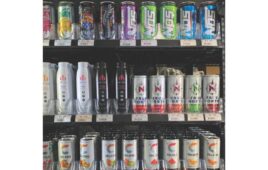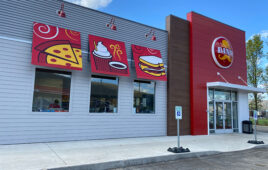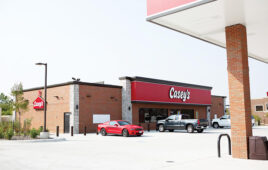 Businesses are increasingly turning to more advanced modes of operation. C-stores are using LED lighting and energy-efficient technology to update their locations and realizing financial and maintenance benefits with the switch.
Businesses are increasingly turning to more advanced modes of operation. C-stores are using LED lighting and energy-efficient technology to update their locations and realizing financial and maintenance benefits with the switch.
The largest benefit (to LED) is energy savings,” said Tara Hughes, senior energy & sustainability analyst, RaceTrac. “After transitioning stores to LED lighting, we were able to reduce lighting energy consumption by approximately 13,000 megawatt-hours. This saved our business approximately $1 million in spend on electricity over the course of the transition to LED.”
Atlanta-based RaceTrac, which operates 567 stores in eight states currently uses LED lighting at all sites, both in the exterior and interior. RaceTrac began the transition to LED lighting as far back as 2013. The chain completed the shift in 2016 and plans to maintain LED lighting specifications at each location, which will ensure all stores continue to employ LED lighting.
RaceTrac does not have to replace bulbs as frequently with LED lighting, which reduces its spend on labor to maintain the stores and costs of energy consumption.
Pilot Co. also uses LED lighting in its travel centers, offices and other locations. Pilot and its Flying J travel center network operate more than 750 locations in 44 states and six Canadian provinces.
“As of January 2022, Pilot has completed lighting upgrades in nearly 475 stores and saved more than 335 million kilowatt-hours of energy by switching to high-efficiency LED lighting. That is the equivalent of 8.99 million incandescent lamps switching to LED,” said Bryan Martin, senior manager, energy and utilities at Pilot Co.
Gilligan’s Retail, which operates 10 sites in Arizona and two in Montana, is another c-store chain that heavily invested in LED lighting, both in the interior and the forecourt.
“Technology is always changing. We are always looking for ways to be more energy efficient and create an environmentally sustainable business that reflects our goals and our customers’ desires,” said Mike Gilligan, vice president of Gilligan’s Retail. “We have been able to achieve many of our goals with LED and utility management, and we continue to keep an eye on the new technology coming out that can increase our energy efficiency.”
 LED Advantages
LED Advantages
Gilligan’s decided to switch to LEDs to increase energy efficiency and decrease maintenance costs, the latter being the main contributor to financial benefits.
“It is also very important to us to have well-lit stores and bright external lighting. Some of our stores are in dense urban environments, and we want our customers to feel safe at night with an inviting store front and forecourt that is well lit,” said Gilligan. “Aesthetically, LED is much nicer than the older fluorescents. They stay a consistent color and do not turn yellow over time as they burn out.”
At Pilot Co., maintenance costs have been saved by switching to LED, as lightbulbs, lamps and ballasts inside the fixtures do not have to be replaced regularly. According to Martin, energy savings is the main benefit to using LEDs.
“In addition to the energy savings, LED improves the appearance of our stores and parking lots,” said Martin. “We pride ourselves on providing guests and team members with bright, well-lit and clean facilities, and LED helps us achieve this. Well-lit facilities are important from both an aesthetic and a safety perspective.”
“In addition to energy savings, using LED lighting provides better lighting clarity, improving the safety of our exterior spaces. LED lighting also reduces unnecessary lighting pollution,” Hughes agreed.
Along with LED lighting, RaceTrac also takes advantage of photocells that it installed to control exterior lighting. The photocells detect lighting levels, Hughes said, allowing the exterior lights to stay on only when the store needs them. This includes nighttime hours and instances of cloudy weather.
“This keeps our stores safe while also being energy efficient,” Hughes said of the photocells.
 Energy Efficiency
Energy Efficiency
At RaceTrac, a few of the chain’s stores underwent a transition from HVAC units with standard efficiency to ultra-high efficiency.
“Our overall goal is to drive energy efficiency at our stores in any way possible. We are continuously investigating new technology and market trends to identify opportunities to make our stores more energy efficient,” Hughes said.
Pilot Co. stores are equipped with energy management systems (EMS), which monitor energy-intensive equipment such as lighting, HVAC and refrigeration. Pilot will continue to use the data from the EMS system to identify patterns and opportunities for continued improvement.
“As part of the New Horizons initiative, the construction team is conducting a test and balance of the HVAC systems as well as evaluating the building envelope for further efficiency improvements,” said Martin.
Gilligan’s contributes to its energy efficiency by using smart thermostats and programing to keep the temperature comfortable. This prevents the energy waste of constantly changing temperatures.




